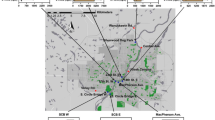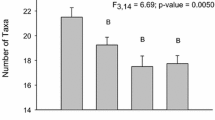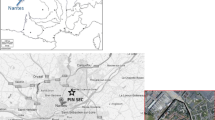Abstract
Unpaved roads make up at least 14 million kilometers of the worldwide road network. Although investigations of road runoff often are focused on paved roads, unpaved roads contribute large volumes of runoff to roadside aquatic habitats and introduce unique constituents to runoff, such as chemical dust suppressants. At least 200 products across five chemical categories are commercially available for road dust suppression and are typically applied at rates up to 4.5 L/m2. Many of these products are poorly described and are lacking basic information on environmental transport, fate, and potential toxicity to roadside organisms. We characterized the aquatic toxicity of 27 commercially available dust control products, including 13 biobased products from the U.S. Department of Agriculture BioPreferred catalog, using juvenile rainbow trout. Acute toxicity varied by more than 1000-fold among products, with 96-h LC50 values ranging from 1.7 to > 16,000 mg/L. Toxicity was not well-predicted by product category. Testing with selected products after simulated weathering under UV radiation did not provide evidence of photoenhanced toxicity. Additional tests with freshwater mussels, juvenile crayfish, pond snails, and amphibian larvae indicated that juvenile rainbow trout were reasonable surrogates for these organisms for a subset of products. This effort represents one of the first comparative studies of dust suppressant toxicity and provides important information for assessing risk to aquatic resources from a widely used but understudied class of contaminants in road runoff.




Similar content being viewed by others
References
Addo JQ, Chenard M, Sanders TG (2004) Road dust suppression: Effect on maintenance, stability, safety and the environment (Phases 1–3). Report MPC-04-156. Mountain Plains Consortium
ASTM International (2019a) Standard guide for conducting acute toxicity tests with fishes, macroinvertebrates, and amphibians (E729-96 (2014)). Annual Book of ASTM International Standards Volume 11.06, ASTM International, West Conshohocken, PA
ASTM International (2019b) Standard guide for conducting laboratory toxicity tests with freshwater mussels (ASTM E2455-06 (2013)). Annual Book of ASTM Standards Volume 11.06. West Conshohocken, PA
Burden N, Benstead R, Clook M, Doyle I, Edwards P, Maynard SK, Ryder K, Sheahan D, Whale G, van Egmond R, Wheeler JR, Hutchinson TH (2016) Advancing the 3Rs in regulatory ecotoxicology: a pragmatic cross-sector approach. Integr Environ Assess Manag 12:417–421
Calfee RD, Little EE (2003) The effects of ultraviolet-b radiation on the toxicity of fire-fighting chemicals. Environ Toxicol Chem 22:1525–1531
Eaton AD, Clesceri LS, Rice EW, Greenberg AE (eds) (2005) Standard methods for the examination of water and wastewater, 21st edn. American Public Health Association, Water Environment Federation, American Water Works Association, Washington, DC
Edvardsson K, Gustafsson A, Magnusson R (2012) Dust suppressants efficiency study: in situ measurements of dust generation on gravel roads. Int J Pavement Eng 13:11–31
Environment Canada (2014) 2013 Air pollutant emissions for Alberta. Air Pollutant Emission Inventory Search, National Pollutant Release Inventory. Environment Canada, Ottawa, Ontario, Canada. http://www.ec.gc.ca/inrp-npri/donnees-data/ap/index.cfm?do=ap_result&process=true§or=&lang=en&year=2013&substance=all&location=AB&submit=Submit
Erickson RJ (2015) Toxicity Relationship Analysis Program (TRAP), Ver 1.30a. EPA/600/C-11/002. U.S. Environmental Protection Agency, Washington, DC
Ettinger WS (1987) Impacts of a chemical dust suppressant/soil stabilizer on the physical and biological characteristics of a stream. J Soil Water Conserv 42:111–114
Gillis PL (2011) Assessing the toxicity of sodium chloride to the glochidia of freshwater mussels: implications for salinization of surface waters. Environ Pollut 159:1702–1708
Goodrich BA, Koski RD, Jacobi WR (2009) Monitoring surface water chemistry near magnesium chloride dust suppressant treated roads in Colorado. J Environ Qual 38:2373–2381
Gosner KL (1960) A simplified table for staging anuran embryos and larvae with notes on identification. Herpetologica 16:183–190
Greening T (2011) Quantifying the impacts of vehicle-generated dust: a comprehensive approach. Transport Research Support Program. World Bank, Washington, DC, p 84
Hermann PM, Bulloch AGM (1998) Developmental plasticity of respiratory behavior in Lymnaea. Behav Neurosci 112:656–667
Irwin K, Hall F, Kemner W, Beighley E, Husby P (2008) Testing of dust suppressants for water quality impacts. Final Report [not numbered]. U.S. Environmental Protection Agency, National Risk Management Research Laboratory, Office of Research and Development. Cincinnati, OH
Jones D (2013) Project report on the development of a selection guide and specifications for unpaved road chemical treatments. Report UCPRC-RR-2013-02. University of California Pavement Research Center, Davis and Berkeley, CA
Kavouras IG, DuBois DW, Nikolich G, Avittia AC, Etyemezian V (2016) Particulate dust emission factors from unpaved roads in the US–Mexico border semi-arid region. J Arid Environ 124:189–192
Khan S, Nugegoda D (2007) Sensitivity of juvenile freshwater crayfish Cherax destructor (Decapoda: Parastacidae) to trace metals. Ecotoxicol Environ Saf 68:463–469
Kociolek A (2013) Unpaved Road Chemical Treatments State of the Practice Survey. FHWA-CFL/TD-13-002. Federal Highway Administration. U.S. Department of Transportation, Lakewood, CO, p 58
Kuhns H, Gillies J, Etyemezian V, Nikolich G, King J, Zhu D, Uppapalli S, Engelbrecht J, Kohl S (2010) Effect of soil type and momentum on unpaved road particulate matter emissions from wheeled and tracked vehicles. Aerosol Sci Technol 44:187–196
Kunz BK, Little EE (2015) Dust control products at Hagerman National Wildlife Refuge, Texas: environmental safety and performance. Transp Res Rec 2472:64–71
Larson RA, Berenbaum MR (1988) Environmental phototoxicity. Environ Sci Technol 22:354–360
Leite MBNL, De Araujo MMS, Nascimento IA, Da Cruz ACS, Pereira SA, Do Nascimento NC (2011) Toxicity of water-soluble fractions of biodiesel fuels derived from castor oil, palm oil, and waste cooking oil. Environ Toxicol Chem 30:893–897
Lippiatt BC (2013) Science-based metrics for product sustainability assessment. In: Jawahir IS et al (eds) Treatise on sustainability science and engineering. Springer, Dordrecht, pp 127–138
Little EE, Fabacher DL (1996) Exposure of freshwater fish to simulated solar UVB radiation. In: Ostrander GK (ed) Techniques in aquatic toxicology. CRC Press Inc, New York, pp 141–158
Mayer FL, Ellersieck MR, Krause GF, Sun K, Lee G, Buckler DR (2002) Time-concentration-effect models in predicting chronic toxicity from acute toxicity data. In: Crane M, Newman MC, Chapman PF, Fenlon J (eds) Risk assessment with time to event models. Lewis Publishing, Boca Raton, FL, pp 39–67
Meijer JR, Huijbregts MAJ, Schotten KCGJ, Schipper AM (2018) Global patterns of current and future road infrastructure. Environ Res Lett 13:1–10. https://doi.org/10.1088/1748-9326/aabd42
Monlux S, Mitchell M (2006) Surface-aggregate stabilization with chloride materials. 0677 1805—SDTDC. U.S. Department of Agriculture, Forest Service, National Technology and Development Program
Partearroyo MA, Pilling SJ, Jones MN (1991) The lysis of isolated fish (Oncorhynchus mykiss) gill epithelial cells by surfactants. Comp Biochem Physiol Part C: Comp Pharmacol 100:381–388
Piechota TC, vanEe J, Batista JR, Stave KA, James DE (2004) Potential environmental impacts of dust suppressants: “Avoiding another Times Beach.” EPA/600/R-04/031. U.S. Environmental Protection Agency in conjunction with the University of Nevada, Las Vegas, Las Vegas, NV
Prosser RS, Rochfort Q, McInnis R, Exall K, Gillis PL (2017) Assessing the toxicity and risk of salt-impacted winter road runoff to the early life stages of freshwater mussels in the Canadian province of Ontario. Environ Pollut 230:589–597
Russell WMS, Burch RL (1959) The principles of human experimental technique. Methuen, London
Singer MM, Aurand D, Bragin GE, Clark JR, Coelho GM, Sowby ML, Tjeerdeema RS (2000) Standardization of the preparation and quantitation of water-accommodated fractions of petroleum for toxicity testing. Mar Poll Bull 40:1007–1016
Singh V, Piechota T, James D (2003) Hydrologic impacts of disturbed lands treated with dust suppressants. J Hydrol Eng 8:278–286
Steevens J, Suedel B, Gibson A, Kennedy A, Blackburn W, Splichal D, Pierce JT (2007) Environmental evaluation of dust stabilizer products. Report ERDC/EL TR-07-X. U.S. Army Corps of Engineers, Engineer Research and Development Center
Sun K, Krause GF, Mayer FL, Ellersieck MR, Basu AP (1995) Estimation of acute toxicity by fitting a dose-time-response surface. Risk Anal 15:247–252
US Environmental Protection Agency (2002) Methods for measuring the acute toxicity of effluents and receiving waters to freshwater and marine organisms, 5th edn. EPA-821-R-02-012. Office of Water, Washington, DC
US Environmental Protection Agency (2017) Technical overview of ecological risk assessment—analysis phase: ecological effects characterization. https://www.epa.gov/pesticide-science-and-assessing-pesticide-risks/technical-overview-ecological-risk-assessment-0. Accessed 5 May 2020
Vaughn CC (2018) Ecosystem services provided by freshwater mussels. Hydrobiologia 810:15–27
Wang N, Ingersoll CG, Greer IE, Hardesty DK, Ivey CD, Kunz JL, Brumbaugh WG, Dwyer FJ, Roberts AD, Augspurger T, Kane CM, Neves RJ, Barnhart MC (2007) Chronic toxicity of copper and ammonia to juvenile freshwater mussels (Unionidae). Environ Toxicol Chem 26:2048–2056
Wang N, Ivey CD, Dorman RA, Ingersoll CG, Steevens J, Hammer EJ, Bauer CR, Mount DR (2018) Acute toxicity of sodium chloride and potassium chloride to a unionid mussel (Lampsilis siliquoidea) in water exposures. Environ Toxicol Chem 37:3041–3049
Weiss M, Haufe J, Carus M, Brandão M, Bringezu S, Hermann B, Patel MK (2012) A review of the environmental impacts of biobased materials. J Ind Ecol 16:S169–S181
Wheeler MW, Park RM, Bailer AJ (2006) Comparing median lethal concentration values using confidence interval overlap or ratio tests. Environ Toxicol Chem 25:1441–1444
Wigginton AJ, Birge WJ (2007) Toxicity of cadmium to six species in two genera of crayfish and the effect of cadmium on molting success. Environ Toxicol Chem 26:548–554
Acknowledgements
Special thanks to E. Scott, H. Puglis, J. Davis, N. Fischer, J. Counihan, L. Johnson, S. Olson, and R. Espejo for laboratory assistance; to R. Surdahl, D. Jones, P. Bolander, L. Fay, and D. James for technical guidance; and to S. Suder, S. Furniss, and S. Finger for overall project support. The work benefitted from the comments of C. Ingersoll, J. Zajicek, C. Schmitt, J. Steevens, and two anonymous reviewers.
Funding
Funding to support this work was provided by the U.S. Federal Lands Highway Refuge Roads Program through the U.S. Fish and Wildlife Service, the U.S. Federal Lands Highway Coordinated Technology Implementation Program (CTIP) through the U.S. Forest Service, and the U.S. Geological Survey Environmental Health Program.
Author information
Authors and Affiliations
Contributions
All authors contributed to portions of the study conception and design. Material preparation, data collection and analysis were performed by Bethany K. Kunz and Edward E. Little. The first draft of the manuscript was written by Bethany K. Kunz, and all authors commented on previous versions of the manuscript. All authors read and approved the final manuscript.
Corresponding author
Ethics declarations
Conflict of interest
The authors declare no conflicts of interest.
Ethics Approval
All animal testing protocols were approved by the USGS Columbia Environmental Research Center (CERC) Animal Care and Use Committee.
Availability of Data and Material
The datasets generated during the current study are available in the USGS ScienceBase repository, (https://doi.org/10.5066/P9VK2LLO).
Disclaimer
Any use of trade, product, or firm names is for descriptive purposes only and does not constitute endorsement by the US Government.
Supplementary Information
Below is the link to the electronic supplementary material.
Rights and permissions
About this article
Cite this article
Kunz, B.K., Little, E.E. & Barandino, V.L. Aquatic Toxicity of Chemical Road Dust Suppressants to Freshwater Organisms. Arch Environ Contam Toxicol 82, 294–305 (2022). https://doi.org/10.1007/s00244-020-00806-y
Received:
Accepted:
Published:
Issue Date:
DOI: https://doi.org/10.1007/s00244-020-00806-y




